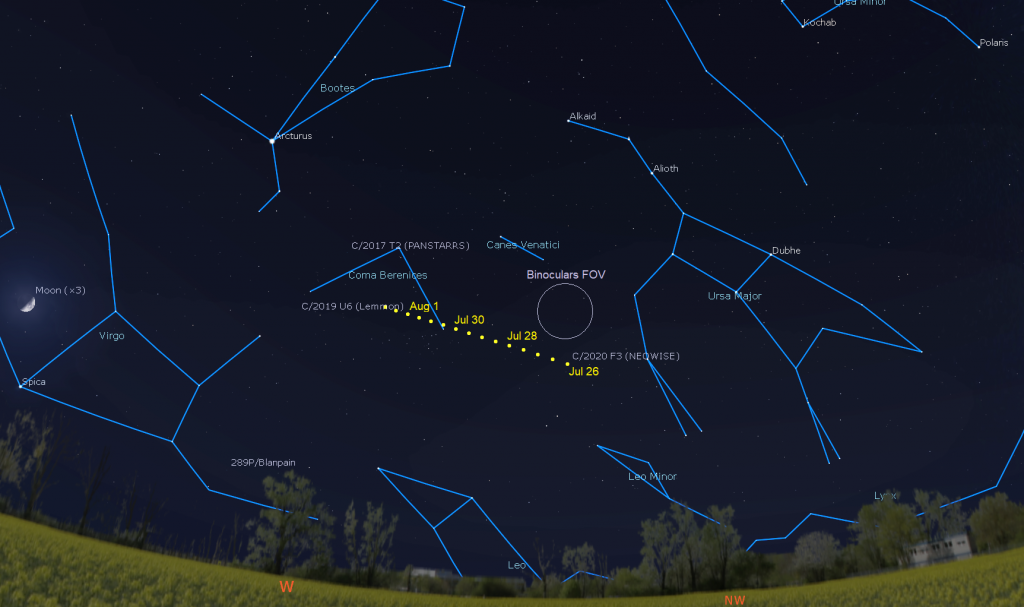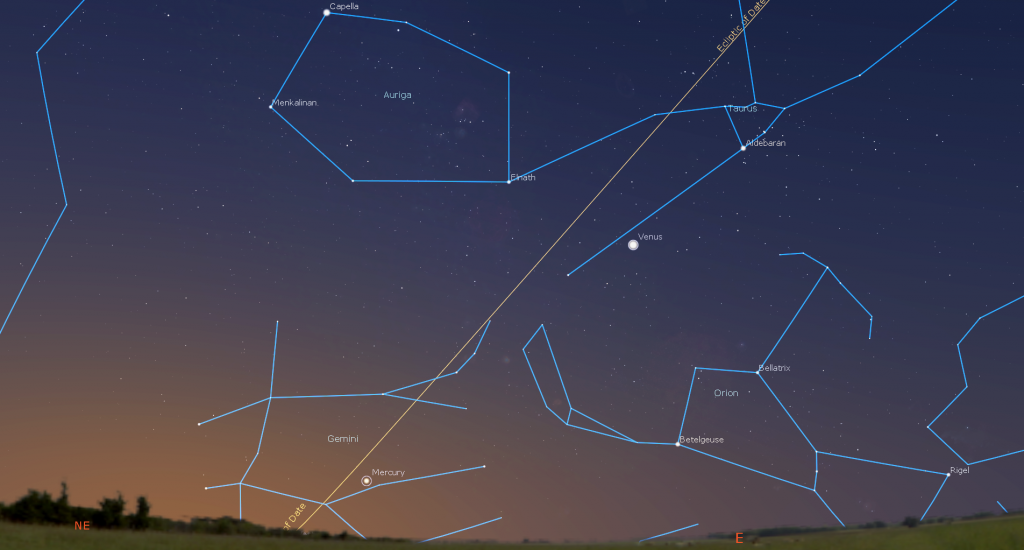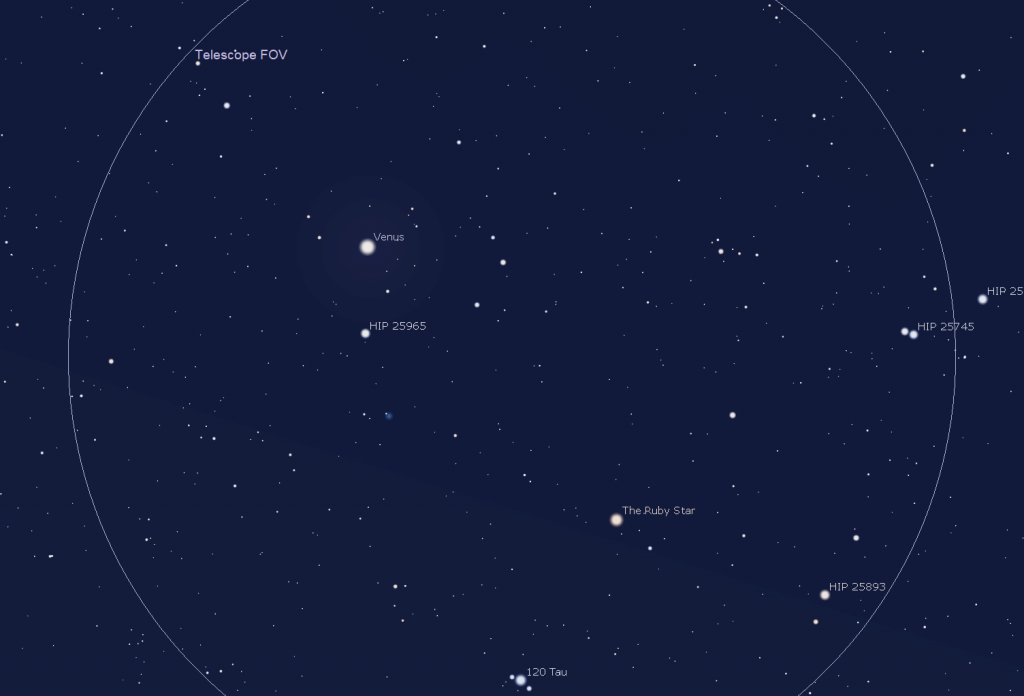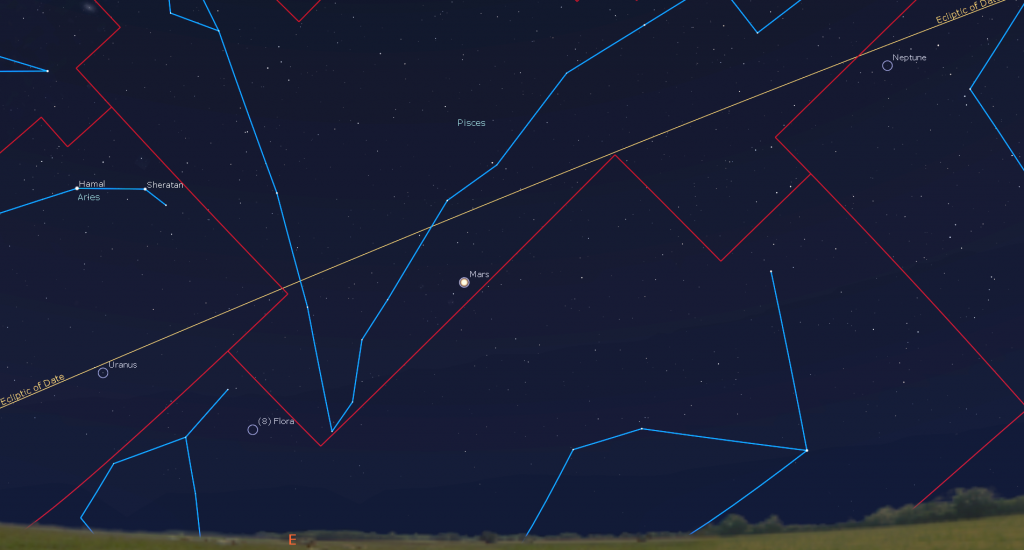Comet NEOWISE Becomes a Binoculars Object, the Evening Moon Meets Pretty Planets, Meteors, and Venus Kisses the Ruby Star!

This simulated image of Saturn for Sunday, July 26 at 10:30 pm EDT shows several of the larger moons labelled and the distinctive Cassini Division that splits the rings.
Hello, Late-July Stargazers!
Here are your Astronomy Skylights for the week of July 26th, 2020 by Chris Vaughan. Feel free to pass this along to your friends and send me your comments, questions, and suggested topics. You can also follow me on Twitter as @astrogeoguy! Unless otherwise noted, all times are expressed in Eastern Time.
I can bring my Digital Starlab portable inflatable planetarium to your school or other daytime or evening event, or teach a session online. Contact me through AstroGeo.ca, and we’ll tour the Universe or the Earth’s interior together!
Comet NEOWISE has faded to a binoculars target in the NW evening sky, to the lower left of the Big Dipper. We get a weak meteor shower. The moon will shine prettily as it waxes fuller and crosses the evening sky all week. Then it will visit Jupiter and Saturn on the weekend – a sight visible around the world. Venus will kiss the Ruby Star. All eight classical planets will still be above the horizon at the same time in the pre-dawn. Here are your Skylights!
Earlier Sunset
We’re a month past the June solstice now. Have you noticed that it’s getting dark earlier? The daylight hours are diminishing by about 2 minutes every day now. Sunset will occur in the Toronto area at 8:46 pm tonight (Sunday). A month ago, that was happening at 9:02 pm.
Southern Delta Aquariids Meteor Shower
The Southern Delta Aquariids meteor shower runs annually from July 21 to August 23. It is caused by the Earth passing through a cloud of tiny particles dropped by a periodic comet – likely Comet 96P/Machholtz and the shower will peak before dawn on Tuesday, July 28, but is quite active for a week surrounding that date. This shower commonly generates 15-20 meteors per hour at the peak, but is best seen from the southern tropics, where the shower’s radiant, in Aquarius (the Water-Bearer), is positioned higher in the sky. The waxing gibbous moon on the peak date will set in early evening, so it should not adversely affect pre-dawn views of the shower.

To increase your chances of seeing meteors, find a dark location with lots of open sky, preferably away from light polluted skies, and just look up with your unaided eyes. Binoculars and telescopes are not useful for meteors because their fields of view are too narrow to fit the streaks of meteor light. Don’t watch the radiant. Any meteors near there will have very short trails because they are travelling towards you. Try not to look at your phone’s bright screen – it’ll ruin your night vision. And keep your eyes heavenward, even while you are chatting with companions. Happy meteor-chasing!
The spectacular Perseids Meteor Shower has begun, too. It will peak in mid-August.
Not-so-Bright Comet NEOWISE This Week
After putting on an exciting show for a couple of weeks, Comet C/2020 F3 NEOWISE has passed Earth on its way back out of the solar system – perhaps to return in about 6000 years. (Space is big!) The comet’s increasing distance from Earth and the continuous reduction in heating from the sun are both causing NEOWISE to fade in brightness over time. I’m not saying that you can’t see it anymore – it’s just a lot harder now. It will be visible in binoculars and telescopes for another couple of weeks, and then become a telescope-only target after about mid-August.
In decent binoculars you should expect to see a small, greenish, fuzzy spot that looks much different from any nearby stars. Unfortunately, the pesky moon will be getting brighter and brighter in the evening sky this week – overwhelming the comet and hiding its faint tail, which will extend generally upwards, away from the sun.
I’ve received quite a few messages from people around the world who are confused about how and when to see the comet – as if it’s just a momentary sight, like a shooting star. Perhaps that’s because images of comets make them look like they are zooming across the sky. In actuality, a comet moves relatively slowly, in human terms. It will appear near certain stars one night, then – as it flies through the solar system, it will re-appear the next night shifted a little compared to those stars. On top of that night-to-night change in position, a comet will be slowly carried across the sky during the night – along with the nearby stars. That’s due to the Earth’s rotation. In other words, once you spot the comet in your binoculars, you can go and grab grandma – or alert the neighbours – or take a bathroom break – because it will still be in almost the same spot when you get back. Just make a note of where you found it. (A good tip is to stand in a particular location that lines the comet up with a building corner or a tree branch – then have your friend, or grandma, stand in that same spot.) By the way – If you see something rapidly crossing the sky, it’s a plane or a satellite – such as the International Space Station – and not Comet NEOWISE.
This week, comet NEOWISE will only become observable in binoculars and telescopes once the moonlit sky darkens enough to allow you to see its faint glow. Then it will be carried lower and lower for several hours as the Earth turns. Things in space become harder to view when they are low in the sky because we are looking at them through a much thicker blanket of air – so try to see NEOWISE early.
From our point of view on Earth, the comet has been heading in a northeasterly direction – through the legs of the Great Bear, Ursa Major, and below the Big Dipper. This week, the comet will continue to climb a bit higher and shift to the left – away from Ursa Major’s bright stars. As the sky darkens tonight (Sunday), the comet will be located about three fist diameters (or 30°) above the west-northwestern horizon (and somewhat higher than that by next weekend). Once the sun has completely disappeared, you can safely sweep the sky for the comet with your binoculars.
After 10:30 pm, the comet will become visible in binoculars – if your skies are clear and not too light-polluted. The easy way to find the comet is to look for the bright star Phecda high in the northwestern sky. It marks the bottom left corner of the Big Dipper’s bowl. The comet will be 1.5 fist diameters to the lower left of Phecda on Sunday and Monday evening.

For the rest of this week, the comet will be the sky below and between the star Alkaid at the end of the dipper’s handle, and the very bright star Arcturus. Let me know if you see it, or get a photo of it! My friend Blake Nancarrow and I recorded a 35-minute video about finding, viewing, and photographing the comet. It’s on the RASC Toronto Centre’s YouTube channel here. I’ve also written a Space.com article about using mobile sky chart apps to find the comet.
Comet NEOWISE has some company in the northwestern evening sky. Three other dim comets, visible in backyard telescopes are there, too! Comet C/2017 T2 (PANSTARRS) and comet C/2019 U6 (Lemmon) are in Coma Berenices (Berenice’s Hair), below Arcturus. And periodic comet 289P/Blanpain is in western Virgo (the Maiden).
The Moon
This is the favorite week of the month for moon-lovers. All over the world, our natural satellite will be shining in the after-dinner sky this week. The moon will reach its first quarter phase on Monday at 8:32 am EDT, or 12:32 Greenwich Mean Time. At that time, the relative positions of the Earth, sun, and moon will cause us to see the moon half-illuminated – on its eastern (right-hand) side. Sunlight striking the moon at a shallow angle along the pole-to-pole terminator line that separates the lit and dark hemispheres will produce spectacularly illuminated vistas – especially under magnification. First quarter moons always rise around mid-day and set at about midnight, so they are visible starting in the afternoon hours. The term “first quarter” refers not to the moon’s appearance, but the fact that the moon has now completed one quarter of its orbit around Earth, counting from the last new moon.
Tonight (Sunday) the moon will sit among the modest (in the sense that they’re dim) stars of Virgo (the Maiden). On Monday and Tuesday, the waxing gibbous moon will pass through Libra (the Scales). On Wednesday the moon will sit above the bright reddish star Antares, the “Rival of Mars”, in Scorpius (the Scorpion). On Thursday night, July 30, the moon will trip over the foot of Ophiuchus (the Serpent-Bearer). On Friday the moon will land above the Teapot-shaped stars of Sagittarius (the Archer).

The moon’s monthly visit with the gas giant planets Jupiter and Saturn will happen on the night of Saturday, August 1. Shortly before dusk, the trio will rise together over the southeastern horizon, with the moon positioned directly below (or to the celestial south of) bright Jupiter. As they cross the sky during the night, the moon will creep east, towards dimmer Saturn, and the diurnal rotation of the sky will move Jupiter below the moon. This conjunction, which will feature an almost full moon, will make a beautiful wide field photo in early evening (or in the southwestern sky around 3 am local time), especially when composed with some interesting foreground scenery.
The Planets
Speedy little Mercury will drop a little lower every morning as it descends sunward. Look for the planet sitting very low in the east-northeastern sky between about 5 and 5:30 a.m. in your local time zone. In a telescope, Mercury will show a 54%-illuminated, waxing crescent phase (but put the telescope away before the sun rises). Mercury’s position below the morning ecliptic during this apparition favours those living near the Equator, and farther south.

Early risers have been amazed by extremely bright Venus, which will rise in the east at about 3 am local time this week, and remain visible until sunrise as it climbs the sky. Viewed in a backyard telescope at medium magnification, Venus will show a slightly slimmer crescent phase than Mercury has. Watch for the very bright, orange-tinted star Aldebaran in Taurus (the Bull) sitting a generous fist’s diameter to Venus’ upper right (or 13° to the celestial west).
On Friday, July 31, Venus will be positioned less than a finger’s width to the upper left (or 0.6 degrees to the celestial north) of the Ruby Star. That star, also designated 119 Tauri and CE Tauri, is a giant, aging, pulsating variable star that shines with a deep red color. The pair will be visible in binoculars and backyard telescopes until the sky begins to brighten. (Note that your telescope will likely flip and/or mirror the binoculars view.) You’ll need to look closely to see the ruby. At magnitude -4.55, Venus will outshine the magnitude +4.3 star by a factor of nearly 3,500!

Blue-green Uranus is rising shortly after midnight local time this week. It’s visible with unaided eyes and in binoculars under a dark sky. Look for the magnitude 5.8 ice giant planet sitting in southern Aries (the Ram) – about a fist’s diameter below the ram’s brightest stars Hamal and Sheratan.
Next in line is Mars, which will put on a great show come October! Mars is steadily increasing in disk size and brightness because Earth is travelling towards it this summer. NASA is scheduled to launch the Perseverance Rover to Mars on July 30. China launched its own Tianwen-1 orbiter and rover to Mars on July 23. And the United Arab Emirates launched the Hope orbiter to Mars on July 19.
You can’t mistake Mars. It’s in the sky between the faint constellations of Pisces (the Fishes) and Cetus (the Whale). Nothing else near it is anywhere as bright, nor as red. Mars will be visible as a prominent reddish dot until dawn, when it will be positioned about five fist diameters above the south-southeastern horizon.
Dim and distant Neptune is located about 2.7 fist diameters to the right (or27° west) of Mars, among the stars of eastern Aquarius (the Water-Bearer). Neptune rises at about 10:30 pm local time and then climbs higher until just before dawn, when you’ll get your clearest view of it, halfway up the southern sky. Neptune is hard to find without a computerized telescope. The nearest medium-bright star is Hydor, which is located a slim fist’s diameter to the planet’s right.

The evening planets are easy ones to see – Saturn and Jupiter! Somewhat dim, yellow-tinted Saturn is chasing brighter, whiter Jupiter across the night sky – lagging it by only a generous palm’s width among the stars of eastern Sagittarius (the Archer). Last Monday, the Earth passed between Saturn and the sun, placing us closest to the giant planet for 2020. It’s still a spectacular sight in backyard telescopes. Its rings, which will be narrowing every year until the spring of 2025, will span 43 arc-seconds. (That’s about the same as Jupiter’s disk). See if you can see the narrow, dark gap that separates Saturn’s inner ring from its outer one. Called the Cassini Division, it’s one of many spaces in the rings!
Even a small telescope will show Saturn’s rings and several of its brighter moons – especially its largest moon, Titan! Because Saturn’s axis of rotation is tipped about 27° from vertical (a bit more than Earth’s axis), we can see the top surface of its rings, and its moons can arrange themselves above, below, or to either side of the planet. During this week in late evening, Titan will migrate counter-clockwise around Saturn, moving from the upper right of Saturn tonight (Sunday) to the lower left of the planet next Sunday. (Remember that your telescope will flip the view around.)
Jupiter will already be shining brightly in the eastern sky at dusk. Good binoculars will reveal Jupiter’s four large Galilean moons named Io, Europa, Ganymede, and Callisto as they dance around the planet from night to night. Even a modest-sized telescope will show Jupiter’s brown equatorial belts and the famous Great Red Spot (or GRS, for short) if the air is steady. Due to Jupiter’s 10-hour period of rotation, the GRS appears every second or third night from a given location on Earth. In the Eastern Time zone, the Great Red Spot will be crossing the planet’s disk after dusk tonight (Sunday), Wednesday, and Friday. It will also appear in late evening on Tuesday, and before dawn on Tuesday, Friday, and next Sunday.
From time to time, the round, black shadows cast onto Jupiter by its Galilean moons are visible in amateur telescopes as they cross (or transit) the planet’s disk for a few hours. On Thursday, Io’s shadow will cross Jupiter from 1:49 to 4:06 am EDT, and again between dusk and 10:35 pm on Friday.
Public Astro-Themed Events
Every Monday evening, York University’s Allan I. Carswell Observatory runs an online star party – broadcasting views from four telescopes/cameras, answering viewer questions, and taking requests! Details are here. Their in-person Wednesday night viewing has been converted to online via the observatory Youtube channel, where they offer free online viewing through their rooftop telescopes, including their new 1-metre telescope! Details are here.
My Insider’s Guide to the Galaxy webcasts with Jenna Hinds of RASC National will continue on Tuesday, July 28 from 3:30 to 5 pm EDT. Details and the schedule are here. Beyond that, join Jenna and John Reid on alternate Thursdays at 3:30 pm EDT as they run through the RASC’s Explore the Universe certificate.
The Canadian organization Discover the Universe is offering astronomy broadcasts via their website here, and their YouTube channel here.
On many evenings, the University of Toronto’s Dunlap Institute is delivering live broadcasts. The streams can be watched live, or later on their YouTube channel here.
The Perimeter Institute in Waterloo, Ontario has a library of videos from their past public lectures. Their Lectures on Demand page is here.
Keep looking up, and enjoy the sky when you do. I love questions and requests. Send me some!